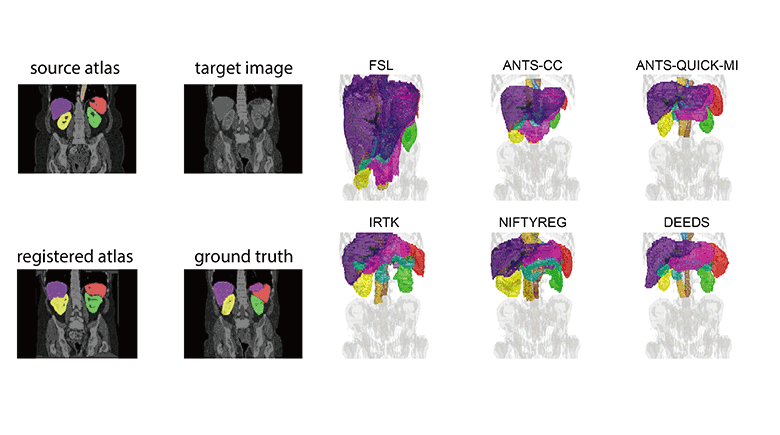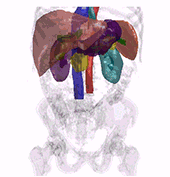Zhoubing Xu, Christopher P. Lee, Mattias P. Heinrich, Marc Modat, Daniel Rueckert, Sebastien Ourselin, Richard G. Abramson, and Bennett A. Landman, Vanderbilt University, USA; Universität zu Lübeck, Germany; University College London, UK; Imperial College London, UK This work evaluates current 3-D image registration tools on clinically acquired abdominal computed tomography (CT) scans. Thirteen abdominal organs (spleen, right kidney, left kidney, gallbladder, esophagus, liver, stomach, aorta, inferior vena cava, portal and splenic vein, pancreas, right adrenal gland, and left adrenal gland) were manually labeled on a set of 100 CT images, and the 100 labeled images (i.e., atlases) were pairwise registered based on intensity information with six registration tools (FSL, ANTS-CC, ANTS-QUICK-MI, IRTK, NIFTYREG, and DEEDS). The Dice similarity coefficient (DSC), mean surface distance, and Hausdorff distance were calculated on the registered organs individually. Permutation tests and indifference-zone ranking were performed to examine the statistical and practical significance, respectively. The results suggest that DEEDS yielded the best registration performance. However, due to the overall low DSC values, and substantial portion of low-performing outliers, great care must be taken when image registration is used for local interpretation of abdominal CT. Based on the results shown in this study, many opportunities are open for future investigation and development for a registration tool tailored for abdomen. First, optimization of the registration configurations could potentially improve the registration performances. Second, contributions in abdominal segmentation also provide some hints toward the potential development of abdominal registration algorithms. Third, we see a new direction in fundamental design for the registration method towards the challenging problems in the abdomen through the discrete optimization of DEEDS. Last, we consider that a structured challenge regarding registration in the abdomen using the presented datasets will further boost the development of abdomen-specific and/or general registration algorithms. All data and source code are available so that innovations in registration can be directly compared with the current generation of tools without excessive duplication of effort.
This work evaluates current 3-D image registration tools on clinically acquired abdominal computed tomography (CT) scans. Thirteen abdominal organs (spleen, right kidney, left kidney, gallbladder, esophagus, liver, stomach, aorta, inferior vena cava, portal and splenic vein, pancreas, right adrenal gland, and left adrenal gland) were manually labeled on a set of 100 CT images, and the 100 labeled images (i.e., atlases) were pairwise registered based on intensity information with six registration tools (FSL, ANTS-CC, ANTS-QUICK-MI, IRTK, NIFTYREG, and DEEDS). The Dice similarity coefficient (DSC), mean surface distance, and Hausdorff distance were calculated on the registered organs individually. Permutation tests and indifference-zone ranking were performed to examine the statistical and practical significance, respectively. The results suggest that DEEDS yielded the best registration performance. However, due to the overall low DSC values, and substantial portion of low-performing outliers, great care must be taken when image registration is used for local interpretation of abdominal CT. Based on the results shown in this study, many opportunities are open for future investigation and development for a registration tool tailored for abdomen. First, optimization of the registration configurations could potentially improve the registration performances. Second, contributions in abdominal segmentation also provide some hints toward the potential development of abdominal registration algorithms. Third, we see a new direction in fundamental design for the registration method towards the challenging problems in the abdomen through the discrete optimization of DEEDS. Last, we consider that a structured challenge regarding registration in the abdomen using the presented datasets will further boost the development of abdomen-specific and/or general registration algorithms. All data and source code are available so that innovations in registration can be directly compared with the current generation of tools without excessive duplication of effort.
Keywords: image registration, abdomen, computed tomography
Research web page: https://www.synapse.org/#!Synapse:syn3193805/wiki/89480

